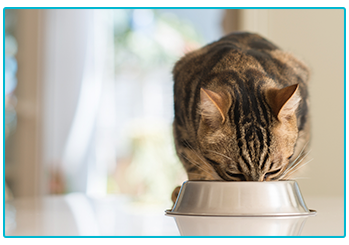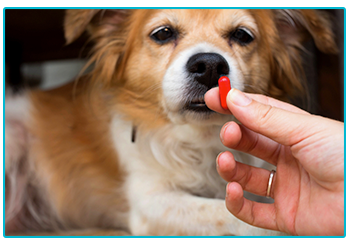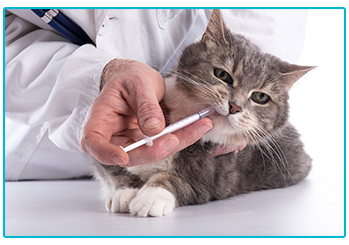Sometimes, giving your dog or cat medication can be an essential part of helping them get over an illness, condition, or recover from treatment. It’s not always easy, and even experienced pet owners can find getting their animal to accept medicines a challenge! We spoke to our pet health expert to get more information about the type of prescriptions you might be given, as well as their tips for how to give your dog or cat medication.

Medication takes different forms
While the first thing that comes to mind when you hear the word medication would be tablets, it can take other forms too! Some may be given as capsules, or in liquid or powder forms. Topical applications, especially for flea and worm treatments, can be popular. Medicine for respiratory conditions are often given in aerosol form, using inhalers or nebulisers.
Read the instructions
When your vet give you a prescription for your animal they will always give you instructions on how to administer it, as well as clearly labelling the packages. It’s important to follow the instructions, as any medication given inappropriately can be harmful to dogs and cats. Some might need to be given with or before food, or without food. If you’re unsure about any of the instructions, consult your vet, who may also be able to give you a copy of the medicines datasheet.
Side effects

As with human medication, those given to pets will come with a range of possible side effects. If you notice any of these, such as vomiting or diarrhoea, you should stop administering it and report the issue to your vet. In the event that you’re worried about the possibility of an overdose, contact your vet as soon as you can.
Getting pets to take medications
By far the easiest way to get your pet to ingest medicine is to hide it within their food. Dogs and cats can be sneaky, however, often eating everything but the medication if they realise what you’re trying to do! Try concealing pills in a tasty treat, such as a piece of sausage, chicken or cheese. The strong smell of fish can help convince picky cats to take their medication, so have a go at hiding it within some tuna or sardines.
Giving medication directly
When a prescription can’t be taken with food, you’ll need to give your pet their medication directly. If you have a cat or a dog that won’t remain still, you may want someone to give you a hand in restraining them, or you can wrap your pet up in a towel like a baby. Avoid using force to keep them still, and if your pet shows aggressive tendencies you shouldn’t give them their medication directly. The best way to make sure they remain still will vary from pet to pet.
Solid Pills

If you need to administer pills directly, follow the advice above. Then, holding the pill between thumb and forefinger, use one hand to tilt your pet’s head back, while using the middle finger of the hand holding the tablet to gently pull their mouth open. Place the pill on the back of the tongue and hold their mouth closed for a few seconds. You can gently rub their throat to encourage swallowing, as well as using a syringe to introduce a tiny amount of tap water into their mouth. Never put your fingers directly into your pet’s mouth, as you could get bitten. If you’re worried about this you can purchase a pill giver from your vet.
Liquid medications
Prescriptions for liquid medication can be given to your cat or dog in the same way as solid pills. If they’re not permitted to take it with food, follow the advice above about making sure your pet is restrained. Don’t give them all the liquid at once. Rather, allow your pet to swallow a little, before administering a little more into their mouth.
Getting your pet to accept their medication can sometimes be a trying time for both of you, but we hope these tips have given you the help you need. If you have any questions, or would like to know more about your cat or dog’s prescription, we recommend speaking to your vet.
All content provided on this blog is for informational purposes only. We make no representations as to the accuracy or completeness of any information on this site or found by following any link on this site. We will not be liable for any errors or omissions in this information nor for the availability of this information. We will not be liable for any loss, injury or damage arising from the display or use of this information. This policy is subject to change at any time.


